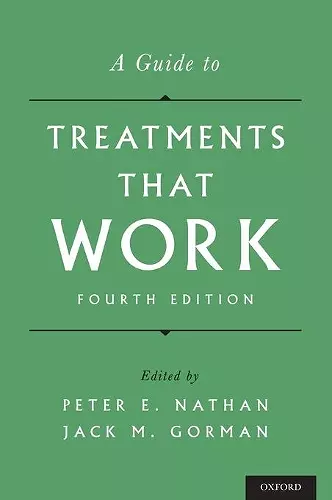A Guide to Treatments That Work
Peter E Nathan editor Jack M Gorman editor
Format:Hardback
Publisher:Oxford University Press Inc
Published:20th Aug '15
Currently unavailable, and unfortunately no date known when it will be back

Like its predecessors, this fourth edition of A Guide to Treatments That Work offers detailed chapters that review the latest research on pharmacological and psychosocial treatments that work for the full range of psychiatric and psychological disorders, written in most instances by clinical psychologists and psychiatrists who have been major contributors to that literature. Similarly, the standards by which the authors were asked to evaluate the methodological rigor of the research on treatments have also remained the same. Each chapter in A Guide to Treatments That Work follows the same general outline: a review of diagnostic cues to the disorder, a discussion of changes in the nomenclatures from DSM-IV to DSM-5, and then a systematic review of research, most of which has been reported within the last few years, that represents the evidence base for the treatments reviewed. In all, 26 of the volume's 28 chapters review the evidence base for 17 major syndromes. Featuring this coverage is a Summary of Treatments that Work, an extended matrix offering a ready reference by syndrome of the conclusions reached by the chapter authors on treatments that work reviewed in their chapters. New to this edition are two chapters at the beginning of the book. Chapter 1 details two perplexing issues raised by critics of DSM-5: the unrealized potential of neuroscience biomarkers to yield more accurate and reliable diagnoses and the lingering problem of conflicts of interest in pharmaceutical research. Chapter 2 contrasts Native American and western ways of identifying effective treatments for mental and physical disorders, concluding that "evidence-informed culture-based" interventions sometimes constitute best practices in Native communities. Two chapters detailing pharmacological treatments for pediatric bipolar disorder (Chapter 9) and pediatric depressive disorder (Chapter 12) have also been added. More than three quarters of the chapters are written by colleagues who also contributed to most or all of the previous editions. Hence, this new edition provides up-to-date information on the quality of research on treatment efficacy and effectiveness provided by individuals who know the research best.
It is remarkably thorough without being overwhelming. The information is readily accessible and is useful for clinicians who are referring to it briefly, or opening it to brush up on the literature in a given area. But this book's main strength is that the authors also are using an evidence-based approach to psychotherapy for many major psychiatric conditions, an area many clinicians unfortunately neglect in their treatment recommendations. This is a worthy effort and one book likely to be used over and over, not accumulating dust on a shelf. * Steven T. Herron, MD (Assurance Health and Wellness); Doodys Notes *
In this book, you will find detailed research and experience-based information on pharmacological and psychological treatments, that work on a long list of disorders relating to human thought and action. * Nano Khilnani, Biz India *
ISBN: 9780199342211
Dimensions: 254mm x 191mm x 56mm
Weight: 1882g
988 pages
4th Revised edition